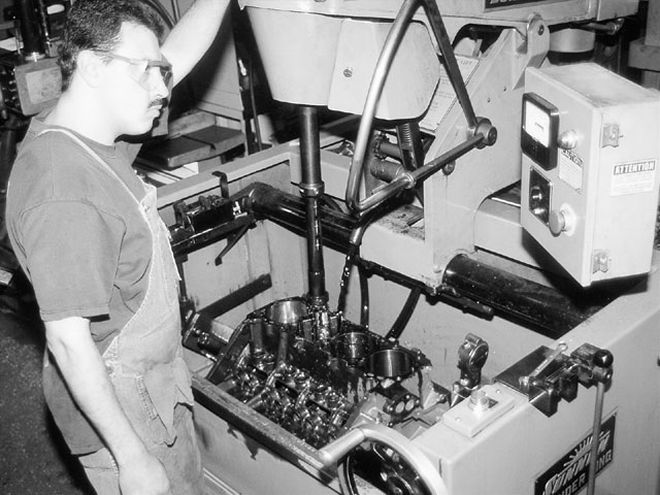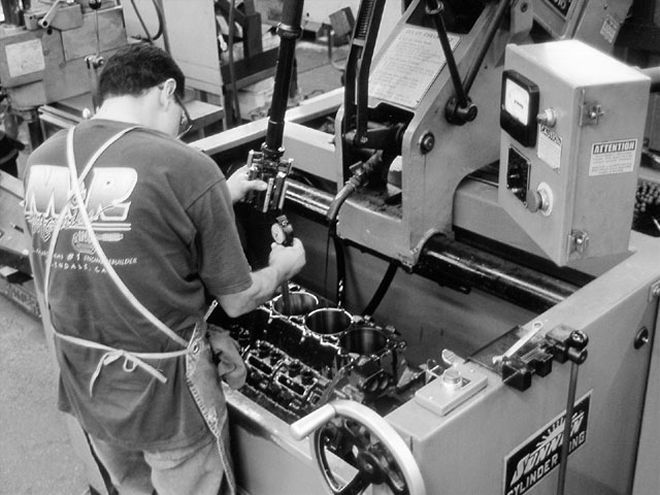
 Making a used block new again begins with boring the cylinders accurately. The heavy duty Rottler bore at M&R is up to the task. Low cost boring bars that bolt to the deck can't compare. Likewise, the success of the honing operation comes down to equipment and operator skill. Ismael at M&R has been at it for 7 years, and the machine is a Sunnen CV 616.
Making a used block new again begins with boring the cylinders accurately. The heavy duty Rottler bore at M&R is up to the task. Low cost boring bars that bolt to the deck can't compare. Likewise, the success of the honing operation comes down to equipment and operator skill. Ismael at M&R has been at it for 7 years, and the machine is a Sunnen CV 616.
The 400 Chrysler has become a sweetheart of the professional race engine builder. Available in abundance, and usually overlooked, the low deck has advantages in certain pure-race applications. With its shorter deck and resultant narrower intake manifold, it offers shorter intake passages that favor high rpm, and arguably increase block rigidity. With room inside for a 440-sized crank, stroker race 400s have become a popular combo. Of course, stroker means more cubes, and to take advantage of those extra cubes, these race combos are usually wearing high flow aftermarket heads. While its merits in stroker form versus the tried and true 440 RB will probably long be argued, in its stock 3.375-inch factory issued stroke, the 400 has its virtues.
The 440's 3.75-inch stroke is a relatively short arm for an engine of its size; the same as found in a 427 Chevy. Now destroke to 3.375-inch, and add .022-inch to the bore, wrap it in a low deck package, and you have the factory-issue 400, with one of the most favorable bore/stroke ratios of any big block of its size. Short stroke, big bore: the formula for high rpm horsepower-if you've got heads with the airflow needed to turn the numbers up there. If you've flowed production big block Mopar heads, its no secret these were produced with mega street torque in mind, while the deep breathing up top was left as the domain of Max Wedge and Hemi heads. Peak horsepower and rpm will ultimately be limited by the airflow available through the heads. With the same airflow and 40 less cubes to fill, the 400 is a natural screamer. Port the heads for big airflow, and it'll wind like a smallblock while delivering big block power.
We were looking at putting the concept to the test in a street 400 application, using readily available mail order parts from Summit. The requirements were a street friendly daily-driver idle, pump gas compatibility, and cost conscious production heads. The requirement for a smooth idle ruled out the use of long, lumpy cams, so we'd depend upon some trick port work to let the air in and turn the numbers we were after.
 Piston-to-wall clearance is critical, and each bore is carefully checked with a dial bore gauge during the honing operation. The cylinders were finished for our Total Seal moly rings, which take a finer finish than cheap cast iron bore eaters.
Piston-to-wall clearance is critical, and each bore is carefully checked with a dial bore gauge during the honing operation. The cylinders were finished for our Total Seal moly rings, which take a finer finish than cheap cast iron bore eaters.
Once the mix is in the cylinder, an engine needs some squeeze to extract the power it carries, and here's were the 400 falls flat.
Production pistons in 400s were over .100-inch short of the deck at TDC. The compression ratio was rated by the factory at 8.2:1, while the true measured ratio was well down in the 7s. Since most replacement pistons (even forged "performance" types) were faithfully modeled on the stock offerings, other than having a set of custom slugs whittled, there was little that could be done. In recent years, KB pistons has filled this hole in the market, offering their excellent hypereutectic pistons for the standard stroke 400 wedge. Problem solved.
Building The Bottom
The starting point for our project 400 was nothing more than a run-of-the-mill thin-wall '78 casting 400 Cordoba motor. Produced in the last year for the big block Chryslers, the '78 400 is not as coveted as the earlier thick-wall block, or the ultra rare first-year block with the heavier main web; but for a street application at .030-inch over, the disadvantages are more mental than physical. One disadvantage of all but a handful of early 400s was the use of a cast iron crank. It is a fact that the cast crank can and does survive in some serious performance applications. It's also a fact that the cast crank has only 65 percent of the strength (tensile, yield, elongation) of a forged piece. The final fact is that there were literally millions of 383s produced with forged steel cranks, and they are a direct bolt-in substitute for the cast 400 crank, adding little to the cost of the build. Swapping to the forged crank will eliminate the need for external balancing and the attendant eccentric damper and weighted converter/flywheel in the process.
As we noted, KB Pistons, a division of piston giant Silvolite, produces the key component in building a high performance 400. The KB-240 answers the call for a reasonably priced off-the-shelf high performance piston for the standard stroke 400. A flat top piston, the KB-240 features deep valve notches for use with high lift cams. The KB piston is cast from Hypereutectic alloy, with proven strength in racing applications, yet allowing the tight cylinder-to-piston clearance desirable in a street engine. With the heat-retaining characteristics of the hypereutectic aluminum from which they are made, and the high top ring placement of the KB design, the top ring gap spec instructed by KB is substantially wider than with conventional pistons allowing room for thermal expansion. Don't ignore their recommendations.
The KB pistons have a nominal compression height of -.020-inch, easily allowing the block to be machined for a zero deck height. We planned on machining for a zero deck which, when used in conjunction with a standard Fel-Pro gasket and 79cc combustion chambers, would yield a compression ratio a hair under 10:1. The pistons would be hung on the stock 400 rods, resized at the big end, and upgraded with ARP bolts.
In an effort to extract as much power as possible from our mildly cammed 400, we opted to order a set of Total Seal Rings. The concept behind the Total Seals is a unique "gapless" second ring. Of course, if there's physically no gap, there's no way to get the ring around the piston. The Total Seal solution is to use a two-piece ring, consisting of a ring and rail. The system staggers the gap of the rail and ring, effectively producing an assembly with no gap for combustion gasses to escape through. The result is that pressure leakdown is reduced to 2 percent or less, and unlike conventional rings in which the gap grows as the ring wears, the Total Seal rings maintain their seal for the life of the ring. Keeping the pressure on the working side of the piston, after all, is where an engine's power comes from. We figured the Total Seal rings were the perfect combo with the wider top ring gap required with the KB pistons. The gapless second would provide a total seal.
With our parts from Summit in hand, the block was taken to M&R Machine in Glendale, California, for prep. M&R uses an oven cleaning system, followed by shot tumbling to remove the accumulated sludge. Next came a Magnaflux crack inspection, which our block passed with ease. The rods were resized and fitted with the ARP bolts, and the forged 383 crank (a $20 core) ground .010-inch under on the main and rod journals. The working parts were then internally balanced on M&R's computerized balancing equipment. Machining was kept to the basics, beginning with boring and honing the cylinders (without torque plates) to the clearances instructed with our KB pistons. The crank was temporarily installed so that a piston/rod assembly could be trial-fitted at each corner, establishing the amount to be machined from the block to achieve a zero deck with the pistons. The line bore was checked and, as is usually the case with a Mopar wedge, was in perfect alignment, requiring no corrective machining. We had new cam bearings installed, and were out the door with the ready-to-assemble block 24 hours after dropping it off.
This month, we'll detail what went into the bottom end, laying the foundation for the street performance piece that will result. We'll follow up in the next issue with the parts that will make the upcoming power play a reality-a trick set of factory iron heads, and a mild mannered cam that belts out numbers which belies its size. Is a stock stroke 400 up to the challenge?